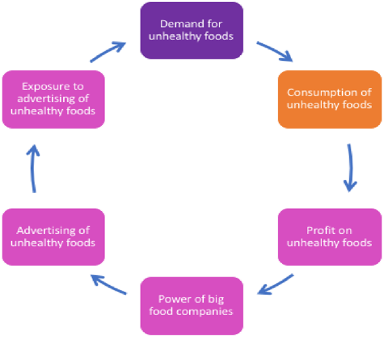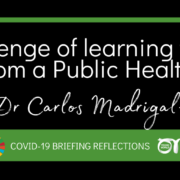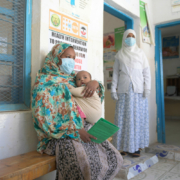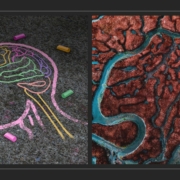A systems approach to the pandemic of COVID-19 & obesity
In 2020, two interconnected pandemics claimed global attention. COVID-19 exposed the fragility of our health care infrastructure. And it brought to the forefront the dire consequences of our inaction to address obesity. Obesity is both a risk factor for severe outcomes of COVID-19, and a consequence of the disease. Now, more than ever, obesity treatment and prevention must be prioritised as a gateway to health; in doing so, the social, economic, environmental, and biological drivers of both obesity and COVID-19 need to inform decision-making processes.
After COVID-19 was declared a public health emergency of international concern, on March 11th, 2020, it soon became clear that people living with obesity were more susceptible to severe SARS Coronavirus 2 (SARS-CoV-2) outcomes. We now know that the risk for hospitalization for people living with obesity is increased by 113%, whilst the risk of death is 48% higher when compared to individuals of normal weight.[i] Adding to growing concerns are the lockdown restrictions and mental health consequences of the pandemic that threaten weight maintenance and weight-loss efforts, with increased levels of physical inactivity worldwide. Obesity is thus considered an effect of the pandemic and cannot be ignored in both developed and developing countries that bear the highest burden of the disease.
We have nine years to meet the UN global development targets, also known as the Sustainable Development Goals(SDGs). We must act swiftly if we are to do so and fix the catastrophically off-track global obesity targets that are further threatened by the COVID-19 pandemic (SDG3.4, SDG3.8, SDG2). Why so? A lack of progress on obesity jeopardizes achievement of the World Health Organization (WHO) Triple Billion Targets that promises 1 billion people living healthier lives.
As an optimist, I do believe that within a crisis, lie seeds of opportunity. There is hope.
But what is the solution?
From the early days of the COVID-19 outbreak in Wuhan, I followed prevalence trends and response priorities. Having finished my MPH two years ago I never imagined living through a pandemic, at least just yet. Dr. David Nabarro’s Open-Online Briefings provided a platform for interactive discussions and a community to grow with. It exposed me to complex systems thinking – a framework to identify and account for interacting influences on COVID-19 and obesity that will be key to progress.
‘Holding the virus at bay requires following the well-established disciplines of disease outbreak control. There are no shortcuts and no quick fixes. Different systems need to be woven together at a local level and be well supported by both national authorities and international programmes. There is a need to do it all and do it well.’ Dr. David Nabarro rightfully says.
What is the missing piece of the puzzle? Youth Voices!
Young people have the innate capacity to see the ‘bigger picture’. They can discover complex interdependencies, including the components of a system that may affect and interact with each other. Their critical tendencies can help us identify barriers in implementing policies, including the incentives and stakeholders that need to be brought to the table. Youth have always been at the forefront of movements for justice and social change, including the Black Lives Matter and Climate Justice movement. They have shown their commitment to activities and improving lives for all.
‘Confronting Obesity: co-creating policy with youth’ (CO-CREATE) a project funded by the European Commission works for youth, with youth. By using a systems approach, the project addresses the unresolved challenges around childhood obesity. Just recently, the perceptions of 257 adolescents (16-18 year old) on the drivers of childhood obesity across Portugal, Poland, Norway, the Netherlands, and the UK were explored.[ii] Collectively youth identified marketing, access to food (both availability and price), stress, anxiety, depression, and low body positivity as factors contributing to the obesity epidemic. Not only did they identify such factors, but they also used a process of ‘mapping’ to illustrate how they are causally related to each other and obesity (see figure 1).

Figure 1 – Commercial Drivers of Obesity. Eur J Public Health, ckaa251, https://doi.org/10.1093/eurpub/ckaa251
We must listen to, and work with the important but often most neglected population group in obesity and COVID-19 research. It will build capacity and support decision-making on key issues that are ahead of us:
- How to re-open schools safely, including the measures that are likely to receive collective support from students.
- How to address the mental health crisis coming in COVID’s wake.
- How to roll-out COVID-19 vaccination programmes, particularly amongst populations with low acceptability.
- How to mitigate and prevent future infectious disease and pandemic outbreaks and the climate change emergency.
We have all lived with COVID-19 for a year now. The virus is here to stay for the foreseeable future. Equally, not one person has been untouched by confinement, and the hardships that the pandemic has given rise to. If not directly, then indirectly due to the lack of support from neighbouring countries during a local emergency. But this makes us powerful!
We are more united than ever, and It is time to take action as a collective. To engage and support one another for equity and justice for the planet. Every Body needs everybody to address obesity & COVID-19, and this includes youth.
Are you struggling to see systems and appreciate them? Dr. David Nabarro provides excellent guidance here. You can also watch the 4SD narrative on COVID-19 and systemic inequality here.
And remember – ‘Great things are not done by impulse, but by a series of small things brought together’.
[i] Popkin, BM, Du, S, Green, WD, et al. Individuals with obesity and COVID‐19: A global perspective on the epidemiology and biological relationships. Obesity Reviews. 2020; 1– 17.
[ii] Savona, N., Macauley, T., Aguiar, A., Banik, A., Boberska, M., Brock, J., Brown, A., Hayward, J., Holbæk, H., Rito, A., Mendes, S., Vaaheim, F., van Houten, M., Veltkamp, G., Allender, S., Rutter, H. and Knai, C., 2021. Identifying the views of adolescents in five European countries on the drivers of obesity using group model building. European Journal of Public Health,.
About this 4SD Reflection

This article is a reflection by Claudia Batz following the COVID-19 Open Online Briefings of Dr. David Nabarro. Claudia is an emerging public health professional and a youth advocate with 2 years of experience in global and public health, Currently a Policy and Projects Coordinator at the World Obesity Federation and a Core Team Member of Young Leaders for Health.
At WOF, she supports the dissemination, communication, and utilisation of outputs from 2 EU consortium childhood obesity projects (CO-CREATE & STOP), and the development of youth-friendly materials, briefings, and resources to help policymakers and others seeking to implement obesity-related policies in their countries. Her previous role involved supporting the enhancement and delivery of the Strategic Centre for Obesity Professional Education(SCOPE).
Claudia is keen to improve health literacy and strives to elicit and bring the perspectives and skills of young people into the strategic design and delivery of health-related programs and policies through her engagements.







Leave a Reply
Want to join the discussion?Feel free to contribute!